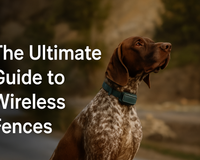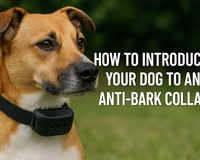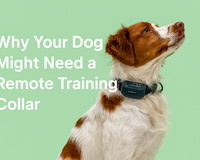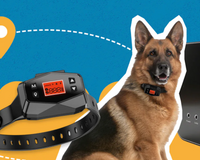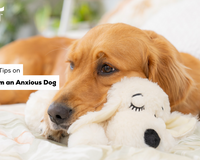It's unfortunate how common dog biting is, but we often forget that dogs are more than just our cute little pets. Dogs are animals and are capable of biting despite how much we trust them.
But what makes your dog want to bite? And what is defined as a dog bite instead of just play biting? We answer all your questions about dog biting and aggression, including the most popular question, "how to stop a dog from biting". Here are some actionable things you can do to train your biting dog.
Reasons for Dog Biting
There are five main reasons why your calm dog transforms into a biting dog.
1. Prey Drive
It's an instinct in all dogs to have some prey drive. Their Prey drive motivates them to hunt. In the wild, this would be for their next meal. Prey drive is present in some way in all dogs; you know when it's kicked in because your dog is shortening the distance between itself and its prey (a bird, cyclist, another dog etc.). This is so they can "catch" the target.
Prey drive can be triggered by someone running past, a cyclist, a bird, or anything that results in a chase. If a dog does decide to chase you, stop moving and stand tall without making eye contact. They should hopefully find you uninteresting now that you've stopped and will move on.
If a dog knocks you over, curl up in a ball to protect your face, hands and neck whilst being still. But, this advice is only valuable if you're being chased by the biting dog, not if you're the owner (how to stop your dog from biting is below).
2. Your Dog is in Pain
Injury or illness can cause your dog to be in so much pain that it may not want to be approached, even by their paw-rents.
If your dog bites and snips for what seems like no reason, consult with your vet first. Make sure to handle the dog gently and stay away from their sore areas.
3. Your Dog is Maternal
Maternal instincts are powerful. The sweetest, well-trained dog can turn into a biting dog when she has puppies. Use caution when handling young puppies, especially if you are around the mother. Make sure the mother and her puppies have space where they can feel safe.4. Your Dog is Anxious
Fear in dogs is usually directed towards the unknown - strangers, new animals, unfamiliar situations etc. Fear bites occur when a dog is startled; a typical example is when a stranger suddenly changes their body language or moves, which startles the dog.
The best way to prevent this sort of dog biting is by socialising your dog when they are young and consistently introducing them to new things.
5. Your Dog is Possessive
Your dog may bite because they think they need to protect their "property". Everyday things they could be "protecting" is food, toys, people or other animals. Training your dog from a young age is the best way to minimise possessive aggression.
To combat food aggression, this might look like: making them wait before eating or interrupting their eating by adding treats to the bowl. For toy possessiveness, teaching the "leave it" command is critical.

5 Different Dog Bite Levels
There are different stages of a dog bite, if left untrained, a level 1 bite will turn into a level 5 bite and cause serious injury.
All levels are serious, if your dog is showing these signs, contact your vet or professional dog trainer immediately.
Level 1: Snapping
Snapping is where the dog bites or snaps the air without making contact with a person.
Level 2: Near Bite
A near bite is where the dog snaps and makes tooth grazes a persons skin.
Level 3: Punctured Skin
A punctured skin bite is where the skin is punctured, but the puncture is shallower than the dog's canine tooth's length.
Level 4: Deep Punctures
A level 4 bite is where the punctures are deeper than the canine tooth's length.
Level 5: Multiple Deep Punctures
This kind of bite can be deadly to children, and the elderly and can seriously injure a person.
How to Stop a Dog From Biting
A dog and its training are under the responsibility of its owner. If you own a biting dog, it is your responsibility to take the time to train your dog.
Seek help from a qualified professional that can help work with you and your dog on their behaviour and triggers.
- Do not discipline your dog with violence or aggression. Consistently reward your dog for desirable behaviour or use safe aversive like remote training collars, but never resort to violence.
- Ensure your dog goes through basic obedience training, and make sure you continue practising these skills. Practising these skills for life will reinforce the desirable behaviours you expect from your dog.
- Socialize your dog often, allow them to meet new people and be in new environments under favourable circumstances. Examples include loud noises, bicycles, cars, adults, children, older people and disabled people and any other situation or type of person that might spark fear.
- Focus on your dog’s behaviour and body language, if you think things are leading to aggression and dog biting you either need to control the situation or remove your dog.
- Always keep your dog in a fenced area or on a leash, do not let them go off-leash unless you know them well and the location permits. If your dog does go off-leash, keep them in sight at all times.
- Finally, if your dog has bitten others or shows other aggressive tendencies, warn others. Don’t allow your dog to wander up to people or other animals unless the situation is under control.

Tools To Prevent Dog Biting
As we mentioned before, if your dog is biting or showing signs of aggression, we always recommend seeking professional help from your veterinarian and a qualified professional first.
We recommend these two tools to help prevent a biting dog from hurting someone. These tools are most effective when layered with other training methods.
1. Remote Training Collar
A remote training collar is a powerful tool for teaching your dog sound commands to improve and change your dog's behaviour.
This style of manual training is very effective and proven. It works by sending a distraction to your dog when you see them doing unfavourable behaviour.
The distraction aims to interrupt your dogs' current behaviour so you can redirect their attention to something else.
For example, suppose they are showing early signs of aggression or arousal. In that case, that is an unfavourable behaviour. You send a distraction to your dog and redirect their behaviour and energy to something else, usually for your dog to come back to your side (recall and heel).
When a dog is overly aroused and excited, they can't hear your verbal command, that's why a dog training collar is so effective. A collar is a great tool to layer with your other training. Your biting dog can transform into a dog that is comfortable socialising and exploring.
2. Muzzle
A muzzle is a sure-fire way to prevent a bite. Your dog can still sniff and communicate; they can't bite. It's also a visual way to warn other owners that your dog is still working on their socialising skills.
Hopefully, other dogs and humans that come near notice the muzzle and don't act in a way that startles your dog.
How to Interact Safely With a Dog
It's easy to get excited when you see a cute dog, but their mood can shift quickly if the dog doesn't know you. These tips are essential for you and the other humans in your life!
- Always ask the owner's permission before you touch or approach an unfamiliar dog. Do not go near the dog if there is no owner.
- When you meet an unknown dog, allow the dog to come to you. Crouch down and let them sniff your hand before you pet them.
- Don't approach a dog that is eating, sleeping, injured or caring for puppies. In these situations, dogs are more likely to be easily startled.
- Don't put your face near an unknown dog.
- Never leave a baby or small child alone with a dog.
- If a dog knocks you over, fall over into the fetal position and cover your face and head. Be still and calm.
- If a dog is trying to fight you, avoid eye contact and remain still.
If you have ongoing difficulty with biting, we recommend engaging with a behavioural specialist or creating an action plan with your vet.
Investing in a remote training collar will help you train your biting dog even quicker. Shop our range here.







